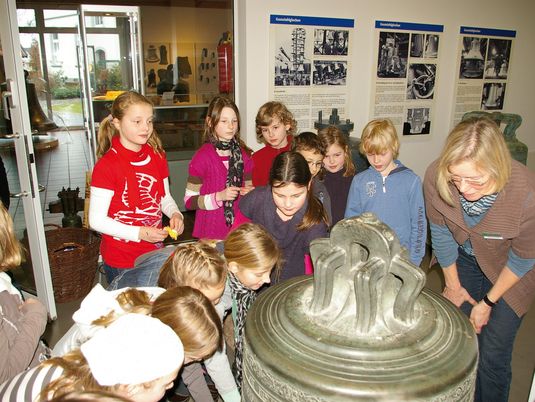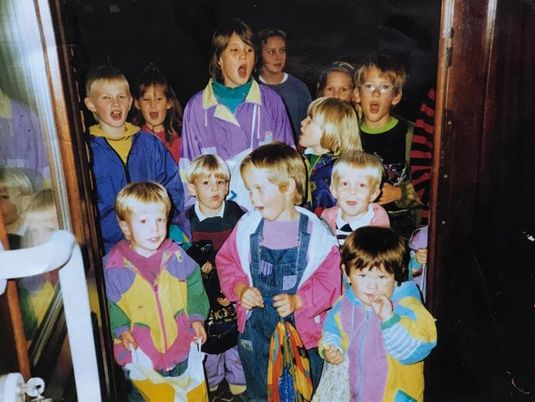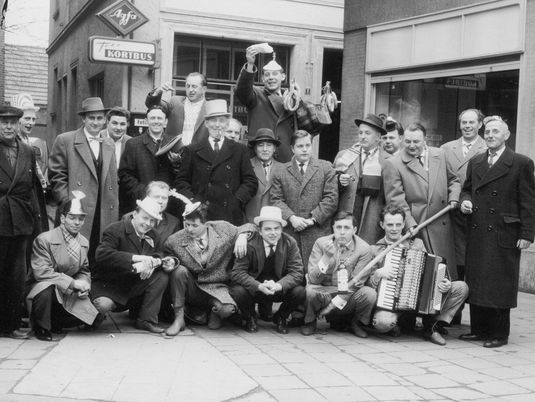Welcome to the farm museum Museumshof
Welcome to the farm museum Museumshof
Gescher has a population of around 17,000 (as of mid-2019). This includes the town’s southern district of Hochmoor. The history of the city covers a period of more than 1,000 years. The once modest linear street village has undergone many changes, especially in the last 150 years. Industrialisation led to a strong increase in the population. Having incorporated the neighbouring communities of Harwick, Tungerloh-Capellen, Tungerloh-Pröbsting, Estern and Büren, Gescher became a town in 1969.
Two Trails – one Project
Feel free to explore the town on the Gescher History Trail and the Gescher Planet Trail. The circular route is marked by signs. On its six-kilometre route, it takes you from Haus Hall through the inner town and from the park to the green belt in the north-east, known as Berkelaue.
History Trail of Gescher and Hochmoor
At each of the trail’s 15 stations, three illustrated information boards have been set up, all distinctively designed. You can learn interesting facts and discover important cornerstones of the town's history. Gescher and its natural environment, dominated by River Berkel, are vividly presented and vital connections are highlighted.
Gescher Planet Trail
This trail consists of 11 stations and together, they form a model of our solar system on a scale of 1:1 billion. Detailed information about the Planet Trail can be obtained from the station "Sun" in the central area of Haus Hall.
Farm Museum „Museumshof - Auf dem Braem“
This is where the city’s cultural heart beats. Visitors and locals alike are attracted by the farm museum Museumshof, the Westphalian Bell Museum, facilities in Heinrich-Hörnemann House (the former town hall), the Kunsthalle (the former coach museum) and the new municipal library.
The name of the farm museum means “on the gorse”. It refers to the sandy areas covered with gorse bushes in and around Gescher.
The historic Munsterland farm has been gradually developed in the former Amtsgarten from 1967. All of its buildings originate from the Gescher area. They were dismantled by the local history association and rebuilt in a garden area behind the former town hall. The site plan at the north entrance on Stadtlohner Strasse provides an overview. Don't miss out on the herb and farmer's garden, an experience for all senses. There are signs on each of the buildings, explaining their special history and use. Enjoy, or as the locals say: Vull Plesier!
For more information on the activities of the history association, visit www.heimatverein-gescher.deCome and have a look. It’s worth it!

Ortseingang von Westen

Hauptstraße – das Herzstück

Ortseingang von Süden

Vom Bauernkotten ...

... (Hof Hörbelt in Büren) ...

... zum Heimathaus
The Westphalian Bell Museum in Gescher
The Westphalian Bell Museum in Gescher
This themed museum opened in 1980 and is located in a former police and administration building in Gescher. Since 2010, the world of bells is presented in a new, contemporary look. Larger, more versatile and equipped with the latest media technology for all age groups, it is a place well worth visiting.
Why not go on a guided tour and experience a musical journey through time and learn all about the long history of bells and bell-founding? You can listen to bells made from bronze, steel and other special alloys, making them ring in different ways. Some bells are rung in a swinging manner, others according to historic pealing traditions, such as by the strike of a clapper, or change ringing. You can also play songs on a glockenspiel, using a so-called Stokken piano. The collection includes bells that were used to announce the time of day or warn of dangers or give other signals, for instance at schools, in shops and factories or on ships.
The heart of the exhibition is the bell pit. Visitors can follow the process of bell making, from the first drawing, through the production of various clay moulds to the actual casting of the bell. There is also a hands-on activity section, where visitors can lift many a bell secret. Visitors may also perform experiments to learn more about the phenomenon of the bell.
The museum is run by the town of Gescher and has been incorporated in the farm museum (Museumshof) since 1989. Special support is provided by the Friends of the Museum, who are always willing to contribute new ideas and funds, also for the acquisition of new exhibits.
Since 2010 the internationally renowned German Bell Museum is affiliated to the Westphalian Bell Museum. This association has a well-equipped specialist library, a photo collection, an archive, and more. It has made its extensive collection of bells available on permanent loan to the Westphalian Bell Museum.
Gescher and the district of Borken, which is in charge of the new cultural centre "KULT" in Vreden, have agreed to cooperate closely in the future development of the Bell Museum.
For a first-hand experience of bell manufacture, why not join a guided tour at Petit & Gebr. Edelbrock on Hauptstrasse 5? This bell and fine art bronze foundry was established in Gescher over 200 years ago. Further information is available at station M.

Amtsgarten um 1960 – heute Museumshof

Bescheidene Anfänge ab 1980

Modell einer Glockengrube

Vielseitige Ausstellung

Interessante Führungen

Museumspädagogik

Stammhaus der Glockengießerei

Lehmformen in Glockengrube

Der Glockenguss

Das fertige Produkt
Local Customs and Traditions
Local Customs and Traditions
Besides the traditions practiced during major religious festivals and prilgrimages, there have always been customs related to personal life in the neighbourhood. Events such as the birth of a child, engagement and marriage, first communion and confirmation, house building and the death of a fellow-citizen are accompanied by customs that demonstrate the special significance of such events and transitions in our lives. Many of them have been handed down from generation to generation and are still frequently and gladly practiced today, sometimes in a modified version. Here are a few examples.
“Little apple, tiny little apple”
The “Appelken” custom, which is so typical of Gescher, is practised on Michaelmas Day, i.e. 29 September. Children go from house to house in their neighbourhood and sing the Appelken song, an old Low German folk song, in order to obtain gifts. After the singing, they get sweets at each door. In former times, they received fruit, especially apples, and not always the best of them.
Bringing sweet bread
After the birth of a child, neighbours took sumptuous raisin bread as well as coffee, butter, milk and sugar to the mother of the child. This was to strengthen her and serve as food for the family and other visitors. After the birth, the young mother was still in bed, which made her unable to bake her own bread. Therefore, her neighbours took care of her and her household. Today this custom has been transformed. Delicious raisin bread is brought along to many a private occasion and shared on the spot.
Bringing the beech tree
When a house is built, the topping out ceremony is of special importance. Neighbours come along with a young beech tree. It is the house owner’s duty to measure the tree’s length. To make things harder, the men carrying it run along the road so that the new home owner has to measure as many metres as possible. Meanwhile, the neighbouring women, who have prepared a topping out wreath, are haggling with the lady of the new house for the price of this beautiful wreath decorated with a bird and colourful ribbons. Finally, the tree and the wreath are attached to the roof so that everyone can see that there is a new building and, sometimes, even a new neighbour.
Lighting a fire
In the olden days, when people moved into a new house, their neighbours gave them a special welcome. They brought along brushwood and lit it in the fireplace. Thus they could find out whether the craftsmen had done their work properly. If smoke escaped well through the chimney, this called for a drink, of course. In times of central heating, this custom has been adapted.

„Äppelken poop Äppelken“

Erst der Gesang – dann Süßes

Kranzbinden am Hochzeitshaus

Fertiger Kranz am Festlokal

Bock wegbringen

Buche bringen

Vögelchen bringen

Kroamstuten bringen

Wurstaufholen